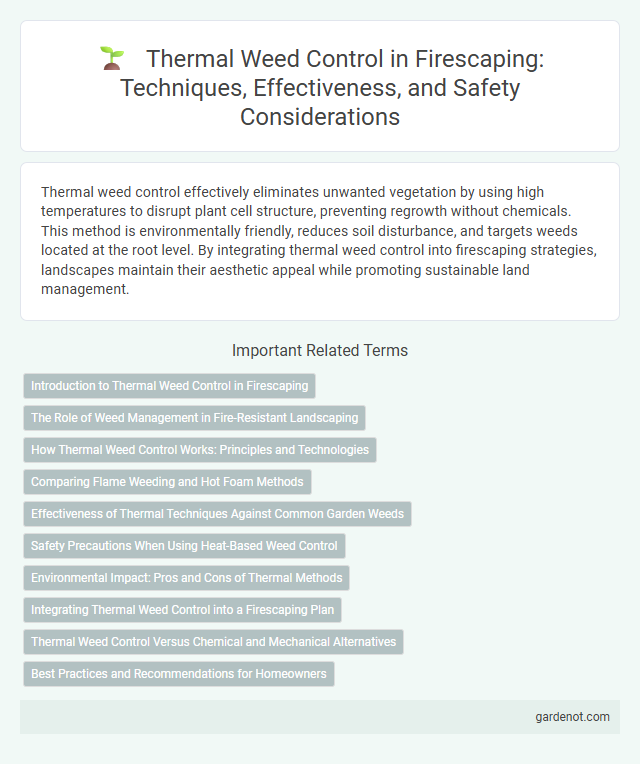Thermal weed control effectively eliminates unwanted vegetation by using high temperatures to disrupt plant cell structure, preventing regrowth without chemicals. This method is environmentally friendly, reduces soil disturbance, and targets weeds located at the root level. By integrating thermal weed control into firescaping strategies, landscapes maintain their aesthetic appeal while promoting sustainable land management.
Introduction to Thermal Weed Control in Firescaping
Thermal weed control uses heat to effectively eliminate unwanted vegetation without chemicals, making it an eco-friendly option in firescaping. This method involves applying direct heat to weeds, causing cell rupture and plant death, reducing fuel loads that contribute to wildfire risks. Incorporating thermal weed control helps maintain defensible space around properties while promoting safer landscapes.
The Role of Weed Management in Fire-Resistant Landscaping
Thermal weed control plays a crucial role in fire-resistant landscaping by eliminating invasive and highly flammable weeds that increase fuel loads. Utilizing methods such as flame weeding or heat treatment effectively reduces ground-level vegetation, minimizing fire intensity and spread. Integrating thermal weed management with fire-adapted plant selections enhances landscape resilience and safety in wildfire-prone areas.
How Thermal Weed Control Works: Principles and Technologies
Thermal weed control eliminates unwanted plants by applying intense heat to disrupt cell structure and protein function, causing weed tissue to wilt and die. Technologies such as flame weeding using propane torches, infrared thermal burners, and hot water or steam treatments achieve targeted heat application without chemicals. These methods efficiently control weeds by rapidly raising temperatures to 70-90degC, ensuring precise, eco-friendly weed management in fire-adapted landscapes.
Comparing Flame Weeding and Hot Foam Methods
Thermal weed control methods, specifically flame weeding and hot foam, offer efficient, chemical-free alternatives for managing invasive plants. Flame weeding uses intense heat to rupture plant cells, quickly desiccating weeds, whereas hot foam smothers them by applying a biodegradable, insulating foam that retains heat longer, allowing for extended thermal exposure. Studies show hot foam can be more effective on dense weed populations and uneven surfaces due to prolonged heat contact, while flame weeding excels in rapid treatment of larger, open areas with lower water consumption.
Effectiveness of Thermal Techniques Against Common Garden Weeds
Thermal weed control techniques, including flame weeding and hot water applications, effectively target common garden weeds such as crabgrass, dandelions, and chickweed by causing cellular damage through rapid heating. Research shows flame weeding reduces weed seedling survival by up to 90%, providing an eco-friendly alternative to chemical herbicides. These methods work best on young, actively growing weeds, ensuring minimal impact on desired plants when applied correctly.
Safety Precautions When Using Heat-Based Weed Control
Thermal weed control effectively eliminates unwanted plants by applying intense heat, but requires strict safety precautions to prevent accidents and property damage. Operators should wear heat-resistant gloves and eye protection, maintain a safe distance from flammable materials, and ensure proper ventilation to avoid inhaling smoke or fumes. Fire extinguishing equipment must be readily available, and using thermal weed control during low-wind conditions minimizes fire risks.
Environmental Impact: Pros and Cons of Thermal Methods
Thermal weed control methods, such as flame weeding and steam treatments, offer an eco-friendly alternative by reducing the reliance on chemical herbicides and minimizing soil contamination. These techniques emit minimal greenhouse gases compared to fossil fuel-based herbicides but require careful management to prevent unintended damage to non-target plants and soil microorganisms. While the immediate environmental impact is lower, repeated thermal applications may disrupt soil biodiversity and organic matter, necessitating balanced usage for sustainable firescaping.
Integrating Thermal Weed Control into a Firescaping Plan
Integrating thermal weed control into a firescaping plan enhances fire-resistant landscaping by targeting invasive and combustible weeds without harmful chemicals. Utilizing propane torches or flame weeding effectively eliminates unwanted vegetation, reducing fuel loads that can exacerbate wildfires. Strategic application of thermal methods supports sustainable maintenance, preserving native plants and minimizing soil disturbance for long-term fire resilience.
Thermal Weed Control Versus Chemical and Mechanical Alternatives
Thermal weed control employs heat, using methods such as flame weeding or hot water, to rapidly destroy weed cells without harmful chemicals. Unlike chemical herbicides, thermal techniques reduce environmental toxicity and decrease soil contamination while offering immediate weed suppression compared to slower mechanical options like tilling or hand-pulling. This approach enhances firescaping efforts by minimizing flammable vegetation efficiently and promoting sustainable weed management without relying on synthetic inputs.
Best Practices and Recommendations for Homeowners
Thermal weed control effectively eliminates weeds by using heat to disrupt cell structure, making it an eco-friendly alternative to chemicals. Homeowners should apply brief, intense flames or hot water treatments early in the morning when weeds are young and soil moisture is adequate to maximize efficiency. Consistent application along driveways, garden beds, and pathways, combined with safety measures such as wearing flame-resistant gloves and avoiding dry conditions, ensures both effectiveness and prevention of accidental fires.
Thermal weed control Infographic

 gardenot.com
gardenot.com